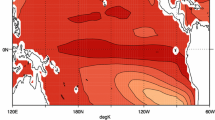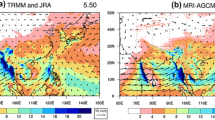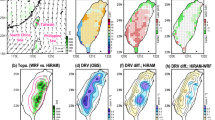Abstract
The impacts of global warming on Meiyu–Baiu extreme rainfall and the associated mid-latitude synoptic-scale weather systems over the Eastern China (EC) and the Baiu rainband (Bu) regions in East Asia have been examined, based on simulations from the 20-km Meteorological Research Institute atmospheric general circulation model (MRI-AGCM3.2S). This model was demonstrated to give realistic Asian extreme rainfall, when compared with data from the Tropical Rainfall Measuring Mission (TRMM). Here we used a novel wave-selection algorithm based on the 300 hPa wind, in order to identify upper-level propagating wave signals in conjunction with the occurrence of extreme precipitation in either EC or Bu. The same algorithm was applied for both the present (1979–2003) and future (2075–2099) climate simulations from the AGCM, so as to infer the impacts of global warming on the behavior of these systems. Results show robust decrease of intensity of systems influencing both Bu and EC in the future warmer climate. Their corresponding low-to-mid level circulation, as revealed by vertical velocity, temperature advection and sea-level pressure composites, was also found to be weakened. This is likely related to changes in the background circulation in future over the East Asian mid-latitude zone, such as the widespread increment of the seasonal mean static stability at 500 hPa. However, the wave-associated precipitation over these regions was enhanced in the future climate simulations. This can be attributed to more strong intensity rainfall, which increases as the background temperature in these regions warms, largely following the Clausius–Clapeyron relation. Therefore, changes of wave-related extreme precipitation in EC and Bu are mainly controlled by the thermodynamic effect; the latter appears to be much stronger than the potential impacts due to the slight weakening of these weather systems.









Similar content being viewed by others
Notes
We also conducted analyses based on 2.5-to-6-day bandpass filtered anomalies. Bandpass filtering in general led to weaker signals; otherwise the results are qualitatively similar to those to be presented in subsequent sections.
Decad is defined as ten-day period.
References
Alexander LV et al (2006) Global observed changes in daily climate extremes of temperature and precipitation. J Geophys Res Atmos 111:1–22. https://doi.org/10.1029/2005JD006290
Allen MR, Ingram WJ (2002) Constraints on future changes in climate and the hydrologic cycle. Nature. https://doi.org/10.1038/nature01092
Berbery EH, Vera CS (1996) Characteristics of the southern hemisphere winter storm track with filtered and unfiltered data. J Atmos Sci 53(3):468–481
Cao F, Gao T, Dan L, Ma Z, Chen X, Zou L, Zhang L (2019) Synoptic-scale atmospheric circulation anomalies associated with summertime daily precipitation extremes in the middle–lower reaches of the Yangtze River Basin. Clim Dyn 53(5):3109–3129
Chang EKM (1993) Downstream development of baroclinic waves as inferred from regression analysis. J Atmos Sci 50(13):2038–2053
Chang EKM, Yu DB (1999) Characteristics of wave packets in the upper troposphere. Part I: northern hemisphere winter. J Atmos Sci 56(11):1708–1728
Chen TJG, Chang CP (1980) The structure and vorticity budget of an early summer monsoon trough (Mei-Yu) over Southeastern China and Japan. Mon Weather Rev 108:942–953
Chen S et al (2013) Similarity and difference of the two successive V6 and V7 TRMM multisatellite precipitation analysis performance over China. J Geophys Res Atmos 118(23):13060–13074. https://doi.org/10.1002/2013jd019964
Chen J et al (2021) Changing impacts of tropical cyclones on east and southeast Asian inland regions in the past and a globally warmed future climate. Front Earth Sci. https://doi.org/10.3389/feart.2021.769005
Coumou D, Lehmann J, Beckmann J (2015) The weakening summer circulation in the Northern Hemisphere mid-latitudes. Science 348(6232):324–327. https://doi.org/10.1126/science.1261768
Dee DP et al (2011) The ERA-Interim reanalysis: configuration and performance of the data assimilation system. Q J R Meteorol Soc 137(656):553–597. https://doi.org/10.1002/qj.828
Ding Y (1992) Summer monsoon rainfalls in China. J Meteorol Soc Jpn 70(1B):373–396
Ding Y, Chan JCL (2005) The East Asian summer monsoon: an overview. Meteorol Atmos Phys 89(1):117–142. https://doi.org/10.1007/s00703-005-0125-z
Ding Y, Sikka DR (2006) Synoptic systems and weather. In: B Wang (ed.) The Asian Monsoon, pp 131–201. https://doi.org/10.1007/3-540-37722-0_4
Ding Y, Liu J, Sun Y, Liu Y, He J, Song Y (2007) A study of the synoptic-climatology of the Meiyu system in east Asia. Chin J Atmos Sci 31(6):1082–1101 (in Chinese)
Donat MG et al (2013) Updated analyses of temperature and precipitation extreme indices since the beginning of the twentieth century: the HadEX2 dataset. J Geophys Res Atmos 118(5):2098–2118. https://doi.org/10.1002/jgrd.50150
Donat MG, Lowry AL, Alexander LV, O’Gorman PA, Maher N (2016) More extreme precipitation in the world’s dry and wet regions. Nat Clim Chang 6(5):508. https://doi.org/10.1038/nclimate2941
Francis JA, Vavrus SJ (2012) Evidence linking Arctic amplification to extreme weather in midlatitudes. Geophys Res Lett. https://doi.org/10.1002/grl.50880
Gao X, Xu Y, Zhao Z, Pal JS, Giorgi F (2006) On the role of resolution and topography in the simulation of East Asia precipitation. Theoret Appl Climatol 86(1–4):173–185. https://doi.org/10.1007/s00704-005-0214-4
Geng Q, Sugi M (2002) Possible change of extratropical cyclone activity due to enhanced greenhouse gases and sulfate aerosols—study with a high-resolution AGCM. J Clim 16(13):2262–2274. https://doi.org/10.1175/1520-0442(2003)16%3c2262:PCOECA%3e2.0.CO;2
Hawcroft MK, Shaffrey LC, Hodges KI, Dacre HF (2012) How much Northern Hemisphere precipitation is associated with extratropical cyclones? Geophys Res Lett 39(24):1–6. https://doi.org/10.1029/2012GL053866
Holton JR, Hakim GJ (2012) An introduction to dynamic meteorology (5th Edition). Academic Press
Huffman GJ et al (2007) The TRMM multisatellite precipitation analysis (TMPA): quasi-global, multiyear, combined-sensor precipitation estimates at fine scales. J Hydrometeorol 8(1):38–55. https://doi.org/10.1175/jhm560.1
Japan Meteorological Agency (2007) Outline of the operational numerical weather prediction at the Japan Meteorological Agency (Appendix to WMO numerical weather prediction progress report)
Kitoh A, Ose T, Kurihara K, Kusunoki S, Sugi M (2009) Projection of changes in future weather extremes using super-high-resolution global and regional atmospheric models in the KAKUSHIN Program: Results of preliminary experiments. Hydrol Res Lett 3:49–53. https://doi.org/10.3178/hrl.3.49
Kusunoki S (2018) Is the global atmospheric model MRI-AGCM3.2 better than the CMIP5 atmospheric models in simulating precipitation over East Asia? Clim Dyn 51(11):4489–4510
Lee DY, Tam CY, Park CK (2008) Effects of multi-cumulus convective ensemble on East Asian summer monsoon rainfall simulation. J Geophys Res Atmos 113(24):1–13. https://doi.org/10.1029/2008JD009847
Lee D et al (2017) Thermodynamic and dynamic contributions to future changes in summer precipitation over Northeast Asia and Korea: a multi-RCM study. Clim Dyn 49(11):4121–4139
Lenderink G, van Meijgaard E (2008) Increase in hourly precipitation extremes beyond expectations from temperature changes. Nat Geosci 1(8):511–514. https://doi.org/10.1038/ngeo262
Li Y, Lau NC, Tam CY, Cheung HN, Deng Y, Zhang H (2021) Projected changes in the characteristics of the East Asian summer monsoonal front and their impacts on the regional precipitation. Clim Dyn. https://doi.org/10.1007/s00382-021-05687-y
Lim EP, Simmonds I (2007) Southern hemisphere winter extratropical cyclone characteristics and vertical organization observed with the ERA-40 data in 1979–2001. J Clim 20(11):2675–2690. https://doi.org/10.1175/JCLI4135.1
Lui YS, Tam CY, Lau NC (2018) Future changes in Asian summer monsoon precipitation extremes as inferred from 20-km AGCM simulations. Clim Dyn. https://doi.org/10.1007/s00382-018-4206-3
Mizuta R et al (2006) 20-km-mesh global climate simulations using JMA-GSM model mean climate states. J Meteorol Soc Jpn Ser II 84(1):165–185. https://doi.org/10.2151/jmsj.84.165
Mizuta R, Matsueda M, Endo H, Yukimoto S (2011) Future change in extratropical cyclones associated with change in the upper troposphere. J Clim 24(24):6456–6470. https://doi.org/10.1175/2011JCLI3969.1
Mizuta R et al (2012) Climate simulations using MRI-AGCM3.2 with 20-km grid. J Meteorol Soc Jpn Ser II 90:233–258. https://doi.org/10.2151/jmsj.2012-a12
Murakami H et al (2012) Future changes in tropical cyclone activity projected by the new high-resolution MRI-AGCM. J Clim 25(9):3237–3260. https://doi.org/10.1175/JCLI-D-11-00415.1
Ninomiya K, Akiyama T (1992) Multi-scale features of Baiu, the summer monsoon over Japan and the East Asia. J Meteorol Soc Jpn 70(1B):467–495. https://doi.org/10.2151/jmsj1965.70.1b_467
Ninomiya K, Shibagaki Y (2007) Multi-scale features of the Meiyu–Baiu front and associated precipitation systems. J Meteorol Soc Jpn 85B:103–122. https://doi.org/10.2151/jmsj.85b.103
Oh SG, Park JH, Lee SH, Suh MS (2014) Assessment of the RegCM4 over East Asia and future precipitation change adapted to the RCP scenarios. J Geophys Res Atmos 119(6):2913–2927. https://doi.org/10.1002/2013JD020693
Pall P, Allen MR, Stone DA (2007) Testing the Clausius–Clapeyron constraint on changes in extreme precipitation under CO2 warming. Clim Dyn 28(4):351–363. https://doi.org/10.1007/s00382-006-0180-2
Rayner NA et al (2003) Global analyses of sea surface temperature, sea ice, and night marine air temperature since the late nineteenth century. J Geophys Res. https://doi.org/10.1029/2002jd002670
Röthlisberger M, Pfahl S, Martius O (2016) Regional-scale jet waviness modulates the occurrence of midlatitude weather extremes. Geophys Res Lett 43(20):10989–10997. https://doi.org/10.1002/2016GL070944
Sampe T, Xie S-P (2010) Large-scale dynamics of the Meiyu–Baiu rainband: environmental forcing by the westerly jet. J Clim 23(1):113–134. https://doi.org/10.1175/2009JCLI3128.1
Shi Y, Wang G, Gao X (2018) Role of resolution in regional climate change projections over China. Clim Dyn 51(5–6):2375–2396. https://doi.org/10.1007/s00382-017-4018-x
Sillmann J, Kharin VV, Zwiers FW, Zhang X, Bronaugh D (2013) Climate extremes indices in the CMIP5 multimodel ensemble: Part 2. Future climate projections. J Geophys Res Atmos 118(6):2473–2493. https://doi.org/10.1002/jgrd.50188
Simmonds I, Lim EP (2009) Biases in the calculation of Southern Hemisphere mean baroclinic eddy growth rate. Geophys Res Lett 36(1):1–5. https://doi.org/10.1029/2008GL036320
Solomon S, Qin D, Manning M, Averyt K, Marquis M (2007) Climate change 2007-the physical science basis: Working group I contribution to the fourth assessment report of the IPCC. Cambridge University Press, Cambridge
Tiedtke M (1993) Representation of clouds in large-scale models. Mon Weather Rev 121:3040–3061
Trenberth KE (1991) Storm tracks in the Southern hemisphere. J Atmos Sci 48(19):2159–2178
Ulbrich U, Leckebusch GC, Pinto JG (2009) Extra-tropical cyclones in the present and future climate: a review. Theoret Appl Climatol 96(1–2):117–131. https://doi.org/10.1007/s00704-008-0083-8
Utsumi N, Kim H, Kanae S, Oki T (2016) Which weather systems are projected to cause future change in mean and extreme precipitation in CMIP5 simulations? J Geophys Res Atmos 121:10522–10537. https://doi.org/10.1002/2016JD025137
Vallis GK (2006) Atmospheric and oceanic dynamics: fundamentals and large-scale circulation. Cambridge University Press, Cambridge
Wang B, Lin H (2002) Rainy season of the Asian-Pacific summer monsoon. J Clim 15(4):386–398
Wang B, Ding Q, Fu X, Kang IS, Jin K, Shukla J, Doblas-Reyes F (2005) Fundamental challenge in simulation and prediction of summer monsoon rainfall. Geophys Res Lett. https://doi.org/10.1029/2005GL022734
Wang XL, Swail VR, Zwiers FW (2006) Climatology and changes of extratropical cyclone activity: comparison of ERA-40 with NCEP-NCAR reanalysis for 1958–2001. J Clim 19(13):3145–3166. https://doi.org/10.1175/JCLI3781.1
Westra S, Alexander LV, Zwiers FW (2013) Global increasing trends in annual maximum daily precipitation. J Clim 26(11):3904–3918. https://doi.org/10.1175/JCLI-D-12-00502.1
Yukimoto S et al (2011) Meteorological Research Institute-earth system model version 1 (MRI-ESM1)—model description. In: Technical Report of the Meteorological Research Institute, 64
Zhao T, Yatagai A (2014) Evaluation of TRMM 3B42 product using a new gauge-based analysis of daily precipitation over China. Int J Climatol 34(8):2749–2762. https://doi.org/10.1002/joc.3872
Acknowledgements
The authors would like to thank Dr. Akio Kitoh for generously sharing the MRI-AGCM outputs from the KAKUSHIN Program, and Profs. Edmund Chang and Joong-Bae Ahn for discussions. NCL at the Chinese University of Hong Kong is partially supported by the AXA Research Fund.
Author information
Authors and Affiliations
Corresponding author
Additional information
Publisher's Note
Springer Nature remains neutral with regard to jurisdictional claims in published maps and institutional affiliations.
Supplementary Information
Below is the link to the electronic supplementary material.
Rights and permissions
About this article
Cite this article
So, K.W., Tam, CY. & Lau, NC. Impacts of global warming on Meiyu–Baiu extreme rainfall and associated mid-latitude synoptic-scale systems as inferred from 20km AGCM simulations. Clim Dyn 59, 1849–1861 (2022). https://doi.org/10.1007/s00382-021-06072-5
Received:
Accepted:
Published:
Issue Date:
DOI: https://doi.org/10.1007/s00382-021-06072-5




